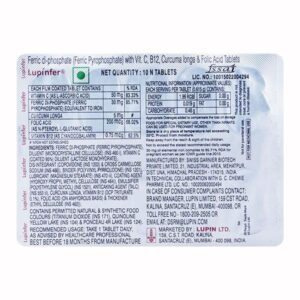FOLIC ACID + FERRIC PYROPHOSPHATE
Folic Acid: Folic acid, also known as vitamin B9, is a synthetic form of folate that is used as a dietary supplement and medication. It is essential for DNA synthesis, red blood cell production, and proper cell division. Folic acid is primarily used to treat or prevent folate deficiency, which can lead to megaloblastic anemia and various neurological disorders.
The mechanism of action of folic acid involves its conversion to dihydrofolic acid and tetrahydrofolic acid in the body. These forms of folate are necessary for the synthesis of purines and pyrimidines, the building blocks of DNA. By providing an exogenous source of folate, folic acid supplementation ensures adequate levels for normal cellular metabolism.
Folic acid is available in tablet form and can be taken orally with or without food. The recommended daily dose varies depending on the individual’s age, sex, and medical condition. For adults, the typical dose to treat folate deficiency is 400-800 micrograms per day, while pregnant women may require higher doses.
While folic acid is generally considered safe and well-tolerated, it may have some side effects. Common side effects include nausea, loss of appetite, bloating, flatulence, and a bitter taste in the mouth. These side effects are usually mild and resolve on their own. In rare cases, allergic reactions, such as rash, itching, or swelling, may occur and require immediate medical attention.
It is important to consult a healthcare professional before starting folic acid supplementation, especially if you have any underlying medical conditions or are taking other medications. Additionally, folic acid supplementation should not be used as a replacement for a healthy diet and should be used under medical supervision, particularly in certain populations, such as pregnant women or individuals with conditions like epilepsy or cancer.
Ferric Pyrophosphate: Ferric Pyrophosphate is a drug used for the treatment of iron deficiency anemia in adults with chronic kidney disease who are on hemodialysis. It is available as an injectable formulation and is administered intravenously during hemodialysis sessions.
The mechanism of action of Ferric Pyrophosphate involves the release of iron from the complex, which is then transported across the dialyzer membrane and bound with transferrin in the blood. Iron is essential for the production of red blood cells, and by replenishing iron stores, Ferric Pyrophosphate helps in the treatment of anemia.
The recommended dose of Ferric Pyrophosphate is 8 mg, administered by slow injection into the venous line of the dialysis circuit over approximately 2 minutes. The injection should be completed within 10 minutes of the completion of the hemodialysis session. The drug is typically administered 1 to 3 times per week, based on the patient’s iron deficiency and hemoglobin levels.
Common side effects of Ferric Pyrophosphate include hypophosphatemia (low levels of phosphorus in the blood), peripheral edema (swelling in the hands, feet, or ankles), muscle spasms, and diarrhea. Less common but more severe side effects may include hypersensitivity reactions, hypotension (low blood pressure), and iron overload. Patients should be closely monitored for signs of an allergic reaction, and appropriate medical treatment should be administered if needed.
Overall, Ferric Pyrophosphate is an effective treatment option for iron deficiency anemia in chronic kidney disease patients on hemodialysis. However, it is essential to follow the recommended dosage and guidelines and monitor for any potential side effects. Consult a healthcare professional for personalized advice and guidance regarding this medication.

